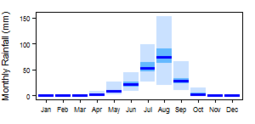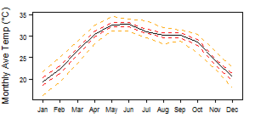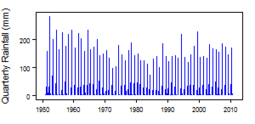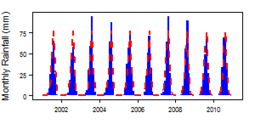Hydrogeology of Niger: Difference between revisions
No edit summary |
No edit summary |
||
| Line 125: | Line 125: | ||
!colspan="4"| Iullemeden (or Niger) Basin - Sedimentary | !colspan="4"| Iullemeden (or Niger) Basin - Sedimentary | ||
|- | |- | ||
|Continental Intercalaire, Hamadian Continental | |Continental Intercalaire, Hamadian Continental, unconsolidated sediments | ||
||Cretaceous - | ||Cretaceous - Quaternary | ||
||The Iullemeden Basin stretches across parts of Mali, Niger, Benin and northwest Nigeria (called the Sokoto Basin in northwestern Nigeria). The sedimentary sequence includes, from oldest to youngest, sandstones and mudstones of the Continental Intercalaire; coarse grained sandstones of Middle and Upper Cretaceous age; marine and lagoonal limestones, dolomitic limestones and sandstones of Cenomanian to Turonian age; argillaceous siltstones and clays of the Upper Cretaceous; and chalky limestones, mudstones and shales of Tertiary age. The total sedimentary sequence in the basin reaches several thousand metres thick. | ||The Iullemeden Basin stretches across parts of Mali, Niger, Benin and northwest Nigeria (called the Sokoto Basin in northwestern Nigeria). The sedimentary sequence includes, from oldest to youngest, sandstones and mudstones of the Continental Intercalaire; coarse grained sandstones of Middle and Upper Cretaceous age; marine and lagoonal limestones, dolomitic limestones and sandstones of Cenomanian to Turonian age; argillaceous siltstones and clays of the Upper Cretaceous; and chalky limestones, mudstones and shales of Tertiary age. Much of the basin is topped with unconsolidated Quaternary sediments, including aeolian sands and alluvial deposits. | ||
The total sedimentary sequence in the basin reaches several thousand metres thick. | |||
|- | |- | ||
!colspan="4"|Mesozoic to Palaeozoic Sedimentary | !colspan="4"|Mesozoic to Palaeozoic Sedimentary | ||
Revision as of 15:43, 23 September 2015
Africa Groundwater Atlas >> Hydrogeology by country >> Hydrogeology of Niger
Most of the textual information on this page was taken from the chapter on Niger in the report
‘Groundwater in North and West Africa’ (UN 1988).
If you have more recent information on the hydrogeology of Niger, please get in touch.
Compilers
Dr Kirsty Upton and Brighid Ó Dochartaigh, British Geological Survey, UK
Geographical Setting

General
| Estimated Population in 2013* | 17,831,270 |
| Rural Population (% of total) (2013)* | 81.8% |
| Total Surface Area* | 1,266,700 sq km |
| Agricultural Land (% of total area) (2012)* | 35.4% |
| Capital City | Niamey |
| Region | Western Africa |
| Border Countries | Nigeria, Benin, Burkina Faso, Mali, Algeria, Libya, Chad. |
| Annual Freshwater Withdrawal (2013)* | 983.6 Million cubic metres |
| Annual Freshwater Withdrawal for Agriculture (2013)* | 66.7% |
| Annual Freshwater Withdrawal for Domestic Use (2013)* | 30.0% |
| Annual Freshwater Withdrawal for Industry (2013)* | 3.3% |
| Rural Population with Access to Improved Water Source (2012)* | 42.1% |
| Urban Population with Access to Improved Water Source (2012)* | 98.7% |
* Source: World Bank
Climate
-
Koppen Geiger Climate Zones
-
Average Annual Precipitation
-
Average Temperature
For further detail on the climate datasets used see the climate resources section.
Surface water
|
|
 |
Soil
 |
Land cover
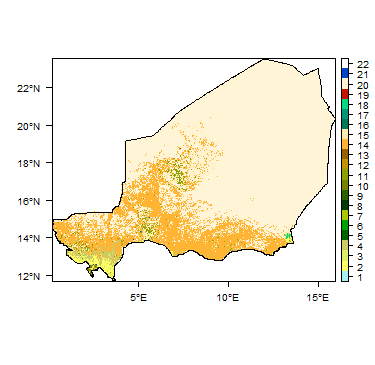 |
Geology
This section provides a summary of the geology of Niger. More information is available in the report UN (1988) (see References section, below).
The geology map shows a simplified version of the geology at a national scale.
|
|
 |
| Key Formations | Period | Lithology | |
| Unconsolidated Sedimentary | |||
|---|---|---|---|
| Largely alluvium and aeolian deposits | Quaternary | Outcrops of Quaternary deposits occur across the country, including alluvium in river valleys, and areas of aeolian sand dunes in the more arid areas. | |
| Chad Basin - Sedimentary | |||
| Chad Formation, Continental Terminal | Cretaceous - Quaternary | The Chad Basin includes a great thickness of sedimentary rocks. The uppermost Chad Formation is largely of Quaternary age, and can reach many 100s of metres thick. It consists of unconsolidated fine to coarse grained sands and gravels with sandy clays. These are lake-margin, alluvial fan, deltaic and aeolian deposits, interbedded with lacustrine clay layers. Abrupt changes in clay and sand content are common, and the sediments usually occur as overlapping lenses.
The Chad Formation is underlain by the largely Tertiary Continental Terminal formation, which consists of alternating, usually loosely consolidated, sandstones, siltstones, shales and mudstones. | |
| Iullemeden (or Niger) Basin - Sedimentary | |||
| Continental Intercalaire, Hamadian Continental, unconsolidated sediments | Cretaceous - Quaternary | The Iullemeden Basin stretches across parts of Mali, Niger, Benin and northwest Nigeria (called the Sokoto Basin in northwestern Nigeria). The sedimentary sequence includes, from oldest to youngest, sandstones and mudstones of the Continental Intercalaire; coarse grained sandstones of Middle and Upper Cretaceous age; marine and lagoonal limestones, dolomitic limestones and sandstones of Cenomanian to Turonian age; argillaceous siltstones and clays of the Upper Cretaceous; and chalky limestones, mudstones and shales of Tertiary age. Much of the basin is topped with unconsolidated Quaternary sediments, including aeolian sands and alluvial deposits.
The total sedimentary sequence in the basin reaches several thousand metres thick. | |
| Mesozoic to Palaeozoic Sedimentary | |||
| Cambrian to Cretaceous | These sedimentary rocks include Ordovician sandstones and limestones; Devonian argillaceous sandstones; Carboniferous calcareous sandstones; and sandstones and siltstones of Triassic and Jurassic age | ||
| Basement | |||
| Precambrian | Plutonic grantitic and gneissose and undifferentiated crystalline metamorphic rocks. | ||
Hydrogeology
This section provides a summary of the hydrogeology of the main aquifers in Niger. More information is available in the report UN (1988) (see References section, below).
The hydrogeology map shows a simplified version of the type and productivity of the main aquifers at a national scale (see the Aquifer properties resource page for more details).
Unconsolidated
| Named Aquifers | Period | General Description | Water quality |
| Alluvium, aeolian deposits | Quaternary |
Sedimentary - Intergranular Flow
| Named Aquifers | Period | General Description | Water quality |
| Chad Formation, Continental Terminal (Chad Basin) | Tertiary - Quaternary | Overall, dominated by sandstones and loosely consolidated sands with significant permeability, but some areas dominated by low permeability clays. Where clays are interbedded with sandstones, it forms a multilayered aquifer, sometimes artesian.
Surface layers recharged by direct rainfall infiltration; deeper layers have more restricted recharge. |
|
Sedimentary - Intergranular & Fracture Flow
| Named Aquifers | Period | General Description | Water quality |
| Continental Intercalaire, Hamadian Continental | Cretaceous | Sandstones, often coarse grained, and clays, limestones and silts. Unconfined in its eastern part, becoming confined towards the west below younger clays, with artesian conditions found especially in deep valleys. The Tegama sandstones form a particularly productive aquifer unit, about 500 m thick, but buried beneath about 500 m of younger cover. Low direct recharge to unconfined areas because of low rainfall. | |
| Agades or Tchirezrine Group | Triassic - Jurassic | Sandstones forming an unconfined aquifer. Recharge largely from infilration of ephemeral river flow. |
Sedimentary - Fracture Flow
| Named Aquifers | Period | General Description | Water quality |
| Sandstones | Palaeozoic | Sandstone aquifers of Ordovician to Carboniferous age, often deep (e.g an Ordovician aquifer more than 800 m deep). Often confined and artesian. The Carboniferous Farazekat sandstone aquifer has artesian flows of between 3 and 30 m³/hour. Relatively low recharge because of confined conditions. |
Basement
| Named Aquifers | Period | General Description | Water quality |
| Basement | Precambrian | Discontinuous, low productivity aquifers controlled by the thickness and nature of weathering (regolith) and the presence of deeper fractures. Where weathered products are dominated by argillaceous material, yields are particularly low. |
Groundwater Status
Groundwater use and management
Groundwater use
Groundwater is a vital resource in Niger.
Groundwater management
Groundwater monitoring
Transboundary aquifers
For further information about transboundary aquifers, please see the Transboundary aquifers resources page.
References
References with more information on the geology and hydrogeology of Niger can be accessed through the Africa Groundwater Literature Archive.
United Nations. 1988. Groundwater in North and West Africa: Niger. United Nations Department of Technical Cooperation for Development and Economic Commission for Africa.
Return to the index pages
Africa Groundwater Atlas >> Hydrogeology by country >> Hydrogeology of Niger



